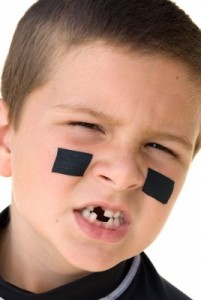
A tooth can be knocked out during a traumatic injury to the mouth or even during play. The front teeth are usually affected. There are different strategies depending on whether the tooth affected is a milk tooth (for younger children) or a permanent tooth (older children and adults).
In the case of a milk tooth being knocked out, it is not advisable for the parents to put the tooth back into the socket. This is because re-implanting the milk tooth may delay the development of the permanent tooth. The child may also need to have additional treatment, including x-rays and local anaesthetic. Re-implantation of the tooth may also have unintended consequences – dental abscesses where the root of the implantation is infected, resulting in pus and painful swelling.
If the tooth in question is a permanent tooth, efforts should be made to save the tooth.
- If you are able to see the dentist within minutes after the tooth has been dislodged, there is a good chance of saving the tooth. The longer the time that elapses between the loss of the tooth and obtaining dental treatment, the less likely the chances of being able to re-implant the tooth.
- Ideally, the tooth should be placed under the tongue where it is bathed in saliva, while on the way to the dentist. In the case of a young child, the parents can place the child’s tooth in their mouth instead.
- Another option is to place the tooth in a glass or container of milk while bringing it to the dentist.
Things to Avoid
The following should be avoided in a situation where a tooth is lost:
- Picking up a tooth by its root – you should pick up the tooth by the crown or enamel instead
- Washing, scrubbing or sterilizing the tooth;
- Storing the tooth in water;
- Wrapping the tooth up in tissue paper or a handkerchief prior to seeing the dentist;
- Delaying several hours to seek dental help.
The actions above could result in the death of cells around the tooth’s root surface which allow reattachment to the bone later.





